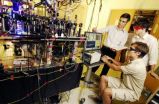(Press-News.org) CINCINNATI – Identification of a molecular communications pathway that influences the mobilization of hematopoietic (blood) stem cells could lead to targeted therapies for improving bone marrow transplant success rates.
In a bed-side to bench approach, researchers at Cincinnati Children's Hospital Medical Center report Sept. 26 in Nature Medicine that pharmacological inhibition of a signaling pathway triggered by Egfr (epidermal growth factor receptor) increased the mobilization of hematopoietic stem cells in mice. The finding provides a scientific basis for enhancing the effectiveness of autologous bone marrow transplants, in which the recipient donates his or her own stem cells prior to the procedure.
"Up to 10 percent of bone marrow donors fail to mobilize sufficient numbers of stem cells, which impedes autologous transplants and significantly delays transplant recovery time," said Hartmut Geiger, Ph.D., a researcher in the division of Experimental Hematology/Cancer Biology at Cincinnati Children's and senior investigator on the study. "Our findings reveal a new rationale for targeted pharmacological approaches to improve stem cell mobilization and transplantation outcomes."
Autologous bone marrow transplant is often used to restore a person's hematologic system after receiving radiation therapy for cancer treatment. Radiation exposure damages the system, which produces all of the body's blood cell types – including those vital to immune system function.
In clinical hematopoietic stem cell (HSC) transplants, the preferred source for mobilizing hematopoietic stem cells from bone marrow into peripheral circulating blood is by targeting a signaling protein called granulocyte colony stimulating factor, or G-CSF. G-CSF stimulates bone marrow so that it releases HSCs into circulating peripheral blood. Mobilization failures and delayed recovery rates suggest the need for a deeper molecular understanding of the mobilization process to further improve the treatment.
This prompted Dr. Geiger and his colleagues to search for therapeutic targets that would boost stem cell mobilization. They work with specially bred mice (recombinant inbred mice) in their research because much of the current knowledge about cellular and molecular regulation of G-CSF-induced stem cells comes from mouse studies. Because the G-CSF process that mobilizes hematopoietic stem and progenitor cells is conserved through evolution between mice and humans, inbred mouse strains are valuable surrogates for studies that can be translated to people.
Working from their previously published research, the scientists were able track a region on chromosome 11 in their mouse models that regulates G-CSF-induced mobilization of HSCs. Of 12 genes located in this region, testing pointed to Egfr, which is a protein involved in triggering molecular reactions that regulate cell growth, multiplication and migration. Mutations in Egfr have also been linked to cancer.
The researchers tested the G-CSF/Egfr pathway's influence on stem cell mobilization in several ways, including genetic manipulation and pharmacologic intervention. In one key experiment, involving mice undergoing bone marrow transplant, the researchers used an anti-cancer drug (Erlotinib) that blocks the Egfr pathway to enhance HSC mobilization. These mice experienced a 5-fold increase in stem cell mobilization.
"This suggests a possible application of these findings into the clinic," Dr, Geiger said. "Experiments are already planned to test whether this novel treatment for enhancing HSC mobilization might translate into novel therapies for patients."
INFORMATION:
First author on the study was Marnie A. Ryan, a research fellow of Dr. Geiger's laboratory team.
Funding support came from the National Institute of Health (NIH) through multiple grants and the Translational Research Initiative at Cincinnati Children's Hospital Medical Center.
Other institutions collaborating on the study include: the department of Dermatology and Allergic Diseases, University of Ulm, Ulm, Germany; Institute of Molecular and Clinical Immunology, Otto von Guericke University, Magdeburg, Germany; department of Biological Sciences, Eastern Kentucky University, Richmond, Ky.; department of Internal Medicine, Markey Cancer Center, Division of Hematology/Oncology, University of Kentucky, Lexington, Ky., and the Hoxworth Blood Center, University of Cincinnati College of Medicine.
About Cincinnati Children's
Cincinnati Children's Hospital Medical Center is one of just eight children's hospitals named to the Honor Roll in U.S. News and World Report's 2010-11 Best Children's Hospitals. It is ranked #1 for digestive disorders and highly ranked for its expertise in pulmonology, cancer, neonatology, heart and heart surgery, neurology and neurosurgery, diabetes and endocrinology, orthopedics, kidney disorders and urology. Cincinnati Children's is one of the top two recipients of pediatric research grants from the National Institutes of Health. It is internationally recognized for quality and transformation work by Leapfrog, The Joint Commission, the Institute for Healthcare Improvement, the federal Agency for Healthcare Research and Quality, and by hospitals and health organizations it works with globally. Additional information can be found at www.cincinnatichildrens.org.
END
Using optically dense, ultra-cold clouds of rubidium atoms, researchers have made advances in three key elements needed for quantum information systems – including a technique for converting photons carrying quantum data to wavelengths that can be transmitted long distances on optical fiber telecom networks.
The developments move quantum information networks – which securely encode information by entangling photons and atoms – closer to a possible prototype system.
Researchers at the Georgia Institute of Technology reported the findings Sept. 26 in the journal ...
DETROIT – Head and neck cancer outcomes associated with race may be more closely linked to social and behavioral factors than biological differences, especially for African Americans, according to a new Henry Ford Hospital study.
Researchers found that while those who self-reported to be African American are at greater risk for late stage cancer, there was no correlation between patients' genetic ancestry and cancer stage or survival.
In fact, the study shows only 5 percent of patients who self-reported to be African American had more than 95 percent West African ancestry. ...
A better way to pinpoint where volcanic eruptions are likely to occur has been produced by an international team of geophysicists.
Scientists from the universities of Leeds, Purdue, Indiana and Addis Ababa, investigated volcanic activity occurring in the remote Afar desert of Northern Ethiopia between 2005 and 2009.
By studying a rare sequence of 13 magmatic events – where hot molten rock was intruded into a crack between the African and Arabian plates – they found that the location of each intrusion was not random. They showed that they were linked because each event ...
Santa Cruz, CA, USA and Oxford, UK, 27 September 2010: Research published this week in Nature Nanotechnology shows a new method of enzyme-controlled movement of a single strand of DNA through a protein nanopore. The paper, by researchers at the University of California Santa Cruz (UCSC), represents a key step towards nanopore sequencing of DNA strands.
The publication describes the observation of single stranded DNA (ssDNA) as it translocates through a protein nanopore, alpha hemolysin (AHL). Movement of the ssDNA was controlled by polymerase-facilitated replication ...
SALT LAKE CITY, Sept. 27, 2010 – If drivers are yakking on cell phones and don't hear spoken instructions to turn left or right from a passenger or navigation system, they still can get directions from devices that are mounted on the steering wheel and pull skin on the driver's index fingertips left or right, a University of Utah study found.
The researchers say they don't want their results to encourage dangerous and distracted driving by cell phone users. Instead, they hope the study will point to new touch-based directional devices to help motorists and ...
STANFORD, Calif. - People go to emergency departments when they've broken a leg, been stabbed or otherwise need urgent care. But a new study from the Stanford University School of Medicine finds that 90 percent of EDs nationwide also offer preventive-care services.
The high prevalence was surprising, said M. Kit Delgado, MD, the study's lead author and a postdoctoral scholar at Stanford's Center for Primary Care and Outcomes Research, and it likely stems from less-than-ideal conditions.
"It's more evidence that our health-care system is dysfunctional," said Delgado, ...
A new analysis finds that men whose partners have breast cancer are at increased risk of developing mood disorders that are so severe that they warrant hospitalization. Published early online in Cancer, a peer-reviewed journal of the American Cancer Society, the study indicates that clinicians should address the mental health of cancer patients' loved ones.
Diseases can compromise the mental health of not only affected patients but of their closest relatives as well. Partners in particular are at risk because they may feel stressed and may be deprived of emotional, social, ...
Working to solve the puzzle of when people develop celiac disease has led researchers from the University of Maryland School of Medicine Center for Celiac Research to some surprising findings. They have found that the autoimmune disorder is on the rise with evidence of increasing cases in the elderly. An epidemiological study published September 27 in the Annals of Medicine supports both trends—with interesting implications for possible treatment and prevention.
"You're never too old to develop celiac disease," says Alessio Fasano, M.D., director of the University of ...
Preliminary findings from an upcoming new report by the International Osteoporosis Foundation (IOF) show alarming projections and reveal the poor state of post-fracture care in the Russian Federation and many other countries in the region. The findings were announced today at a press conference in St. Petersburg at the IOF Summit of Eastern European and Central Asian Osteoporosis Patient Societies.
Osteoporosis, a disease of the bone which leaves people at increased risk of fracture, is most common in the older population. Population projections for most countries in ...
Exposure to common viruses in daycare puts children with a chronic lung condition caused by premature birth at risk for serious respiratory infections, according to a study from Johns Hopkins Children's Center published in the October issue of Pediatrics.
The researchers say their findings should prompt pediatricians to monitor their prematurely born patients, regardless of age, for signs of lung disease and to discuss the risks of daycare-acquired infections with the children's parents. These risks, the researchers found, include increased emergency room visits and ...


